Diagnosing St. Augustine’s Problems
Did you ever have a friend who came with a lot of extra “baggage?” Most of us have. St. Augustine certainly has baggage, and diagnosing its ills can be a challenge even to the best professional turf people.
I’ve grown St. Augustine since I was 10 years old (except for 5 years in Ohio), so I feel like I’m qualified to help sort through the fog.
Here are the most common St. Augustine problems arranged in rough chronological order of when they will appear, spring through late fall. Knowing when a problem first appeared is a giant first step in identifying it.
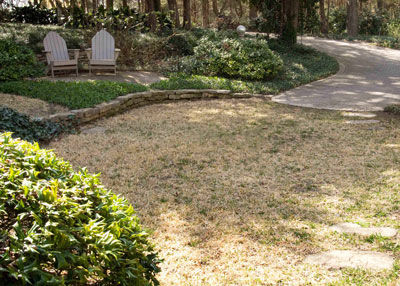
Take All Root Rot (TARR)
• Take All Root Rot (TARR). A problem in April and May (rarely later). Grass is lethargic in greening up. Shows up in blotches and irregular patches. CRITICAL SYMPTOM: Grass pulls loose from the soil easily, because as the name implies, the roots have been rotted by the fungal organism. THE ODDITY: Fungicides don’t do much good. THE FACT: Texas A&M research has shown us that applying a layer of sphagnum peat moss 1 inch deep over the affected area and several feet beyond the edges of the yellowed patches of grass will help greatly. The disease is not active in acidic environments. PERSONAL OPINION: A lot of other St. Augustine problems get diagnosed as TARR and people spend (waste) a ton of money on peat when the problem is something else. (See chinch bugs and shade, below)
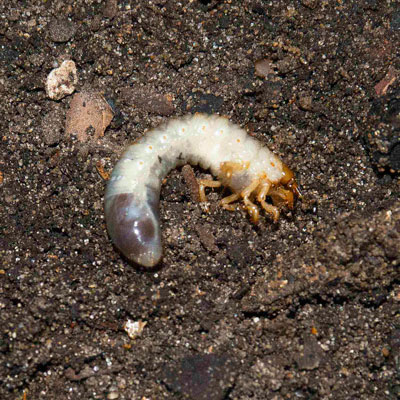
White grub worm
• White grub worms. Damage shows up in the spring. CRITICAL SYMPTOMS: Grass pulls loose easily from the soil because roots have been eaten by the white grubs (larvae of June beetles – the small beetles that fly in late May in South Texas into mid-June in North Texas). If you dig several square-foot patches in the afflicted areas you will see 5 or 6 grubs per square feet. If you encounter only one or two, grubs are not the cause. There are insecticides labeled for controlling white grubs soon after they hatch, but this is NOT the time to treat. Merit should be applied the last two weeks of June through mid-July, then watered deeply into the soil. PERSONAL OPINION: Grub worm damage is nowhere near as common now as it was during the epidemic infestations of the 1970s. People need to be sure they’re actually seeing several grubs per square foot and not just several grubs during an entire day spent working in the landscape. Remember: You must have 5 or 6 grubs per square foot for them to do damage. Grass can outgrow smaller populations.
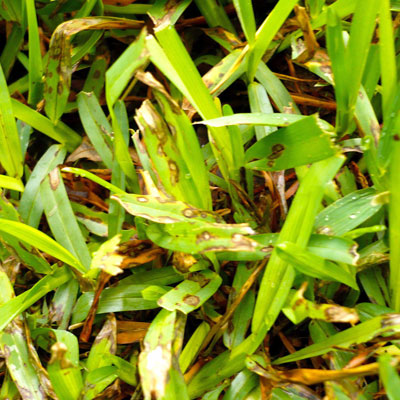
Gray leaf spot in summer
• Gray leaf spot. Shows up in mid-summer. Fungal organism causes the disease, but it is greatly accelerated by application of nitrogen. Lawn has yellowed washes and sweeps when viewed from the sides. Individual blades and even runners will have diamond-shaped, gray-brown lesions slightly bigger than pinhead-sized. Apply labeled fungicide, but do not apply nitrogen between June 15 and early September. Occurs in sun and shade, and can weaken the lawn severely, even kill areas. But does not appear in spring.
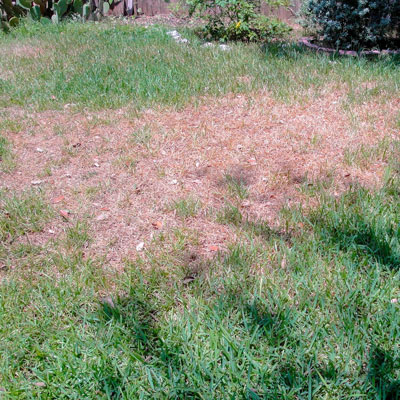
Chinch bugs in summer
• Chinch bugs. Small black insects with white, diamond-shaped patches on their wings. Always in the hottest, sunniest parts of the lawn. Never in shade, and won’t show up until late June through August. Grass will appear dry, but watering won’t perk it back up. Will return to same parts of yard each year. First symptom: grass blades fold and turn glossy olive drab. As mentioned, watering doesn’t help. You must apply a labeled insecticide quickly or the grass will be killed in the afflicted areas. PERSONAL OBSERVATION: 2016 was the worst year I have seen for chinch bugs in my professional career, and many of the problems people are seeing this spring are actually leftover dead grass from chinch bug damage of late summer and early fall 2016. There is no reason to treat now, but you may have to replant with new plugs into the affected areas. I believe chinch bugs are/were a major source of the lawn issues this spring.
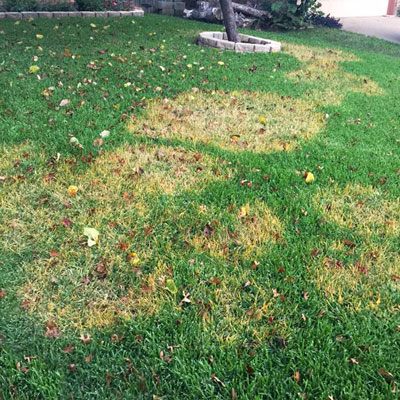
Brown patch in fall
• Brown patch. This is a cool-weather disease that doesn’t show up until late September or October, and mainly after the first fall rains. It is a leaf disease that rots the blades where they attach to the runners. They pull loose easily from the runners. Runners and roots remain healthy and vigorous. Because January 2017 found extremely low temperatures plunging deeply into Texas, St. Augustine lawns in South Texas that normally never turn brown from the cold did so this year. That means that the blades were turned brown by the cold, so there is very little chance of brown patch showing up this spring. PERSONAL OPINION: Most people who think they have brown patch right now actually have some other problem.
• Cold damage. The January 2017 cold spell was bad, but I don’t have the sense that it killed a lot of St. Augustine. The variety Floratam is notably winter-tender, however, and it is commonly planted in the southern third of Texas. If you had Floratam that has been slow to green up, your lawn may have been hurt by the extreme cold. Other varieties probably were not. You may have to replant if cold got your turf.
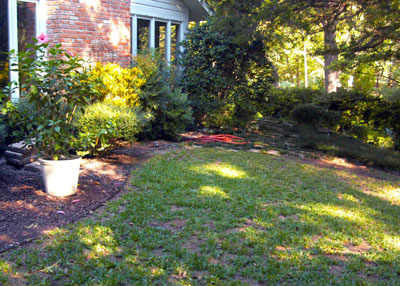
St. Augustine thins in shade
• SHADE! This is the most common question I am asked. (I keep records of every phone call I take on the air, and there have been 450,000 of them over my 40 years. So I have a pretty good sampling.) People ask what kind of grass does best in the shade, and for most of Texas, that answer is St. Augustine (fescue for the Panhandle).
BUT ALL GRASSES, ST. AUGUSTINE INCLUDED, NEED 5 TO 6 HOURS OF DIRECT SUNLIGHT DAILY.
I see people resodding time after time hoping that this will be the year that a miracle happens. (I’ve done it, too.) If you don’t have that much sunlight, there is no grass that will grow there. Either you have to remove a tree or two – or perhaps have a lower branch or two removed, or you have to turn to a shade-tolerant groundcover such as monkeygrass (regular mondograss), liriope, purple wintercreeper, English ivy, etc. Thinning trees won’t offer much long-term help. They will fill back in.
CRITICAL SYMPTOM: If the trunk of your tree is like an arrow in a bulls eye, and if the thinning gets worse as you move toward the outer drip line of the tree, shade is the culprit and you’re wasting money to invest in more sod. This is not about the trees taking moisture or nutrients. It’s all about excessive shade. Remember: no sod farm is in shaded conditions. They’re all in full sun.
(Modified for e-gardens from Facebook post made by Neil on April 13, 2017.)
